Space junk, space debris, space waste — call it what you want, but just as junk and waste cause problems here on Earth, in space spent booster stages, nuts and bolts from ISS construction, various accidental discards such as spacesuit gloves and cameras, and fragments from exploded spacecraft could turn into a serious problem for the future of spaceflight if actions to mitigate the threat are not taken now. The European Space Operations Centre has put together some startling images highlighting this issue. Above is a depiction of the trackable objects in orbit around Earth in low Earth orbit (LEO–the fuzzy cloud around Earth), geostationary Earth orbit (GEO — farther out, approximately 35,786 km (22,240 miles) above Earth) and all points in between.
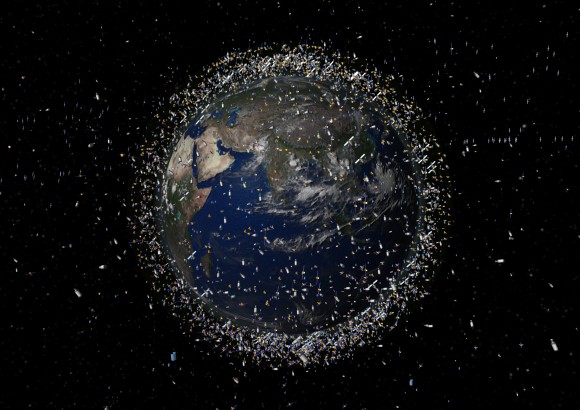
Between the launch of Sputnik on 4 October 1957 and 1 January 2008, approximately 4600 launches have placed some 6000 satellites into orbit; about 400 are now travelling beyond Earth on interplanetary trajectories, but of the remaining 5600 only about 800 satellites are operational – roughly 45 percent of these are both in LEO and GEO. Space debris comprise the ever-increasing amount of inactive space hardware in orbit around the Earth as well as fragments of spacecraft that have broken up, exploded or otherwise become abandoned. About 50 percent of all trackable objects are due to in-orbit explosion events (about 200) or collision events (less than 10).
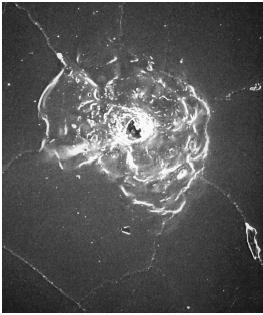
Officials from the space shuttle program have said the shuttle regularly takes hits from space debris, and over 80 windows had to be replaced over the years. The ISS occasionally has to take evasive maneuvers to avoid collisions with space junk. And of course, this debris is not just sitting stationary: in orbit, relative velocities can be quite large, ranging in the tens of thousands of kilometers per hour.
For the Envisat satellite, for example, the ESA says the most probable relative velocity between the satellite and a debris object is 52,000 kilometers per hour. If a debris objects hits a satellite, the ISS or the Shuttle, at those speeds it could cause severe damage or catastrophe.
Above is a depiction of debris in polar orbit around Earth. From the image below, it’s evident how explosions of spacecraft causes even more scattered debris. Even after the end of the mission, batteries and pressurised systems as well as fuel tanks explode. This generates debris objects, which contribute to the growing population of materials in orbit, ranging from less than a micrometer to 10 centimeters or more in size.
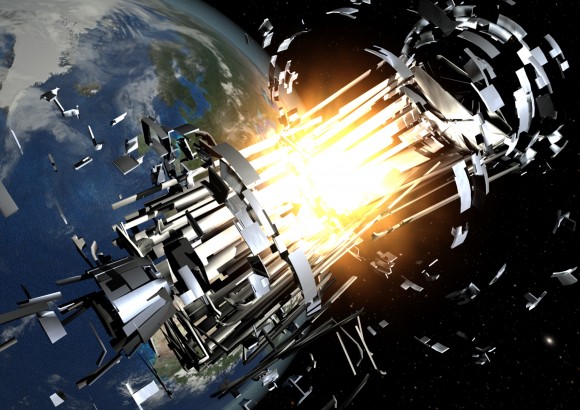
About 40% of ground-trackable space debris come from explosions, now running at four to five per year. In 1961, the first explosion tripled the amount of trackable space debris. In the past decade, most operators have started employing on-board passive measures to eliminate latent sources of energy related to batteries, fuel tanks, propulsion systems and pyrotechnics. But this alone is insufficient. At present rates, in 20 or 30 years, collisions would exceed explosions as a source of new debris.
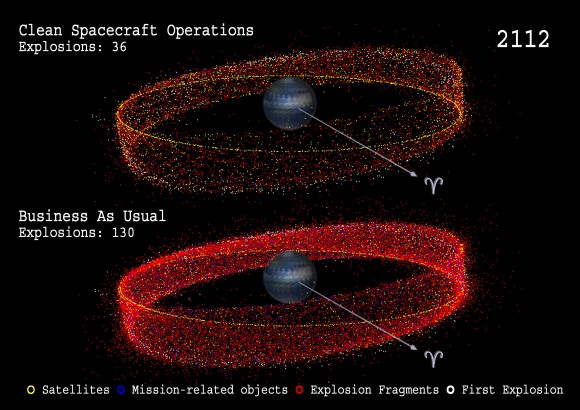
The ESA says it is crucial to start immediately to implement mitigation measures. This image shows a simulation of the the 2112 GEO environment in the case when no measures are taken. In the top panel, with mitigation measures, a much cleaner space environment can be observed if the number of explosions is reduced drastically and if no mission-related objects are ejected. The bottom panel shows the “business-as-usual” scenario, without any mitigation measures taken. However, to stop the ever-increasing amount of debris, more ambitious mitigation measures must be taken. Most importantly, spacecraft and rocket stages have to de-orbited and returned to Earth after the completion of their mission.
They’ll burn up in the atmosphere, or splash down in uninhabited ocean areas. In the case of telecommunication and other satellites operating in the commercially valuable geostationary zone, they should boost their satellites to a safe disposal orbit, as shown below.
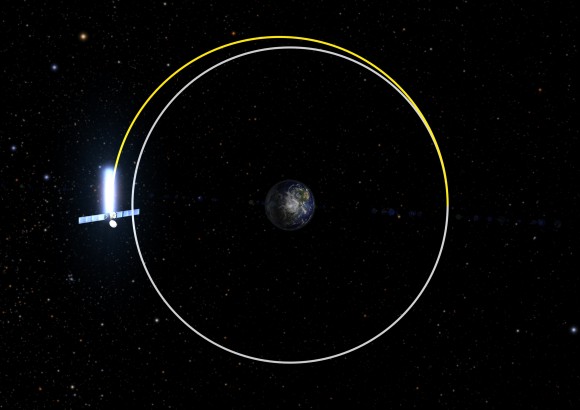
There are other measures, like reducing the number of mission-related objects and controlling the risk for reentry, but these are the basics. The issue is that such mitigation measures cost fuel and operational time, and therefore they increase cost. In the commercial world, this may competitiveness, unless there is an international consensus to accept such costs.
Original News Source: ESA

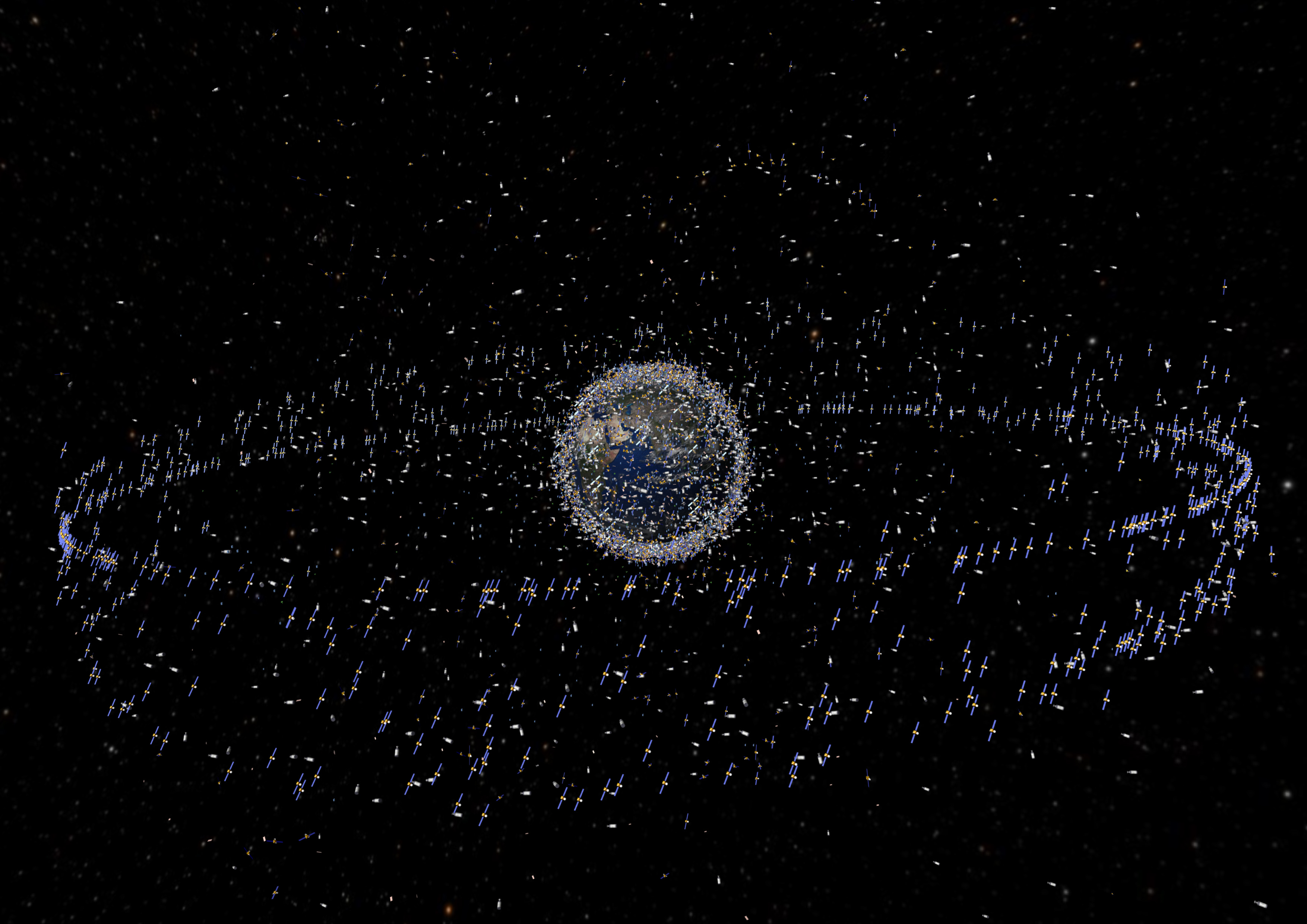

I agree Nathan. Also with a finite amount of resources on Earth you have to wonder when the value of this space junk will be such that we will need to bring it back and recycle it.
They demoted Pluto from the list of planets because it hadn’t
cleaned up it’s orbit. If this littering keeps up we’ll have to demote earth too.
The inclusion of a “suicide” thruster in satellite design would allow the items to de-orbit when their service life was over. This could reduce some of the debris. This was proposed in the early ’60s, but the idea died.
Humans..pff. We are so dirty that we even have a pollution problem orbiting our planet. We are a parasitic species.
Regardless of the merits of this article, the potential for debris striking a functional satellite or the ISS or one of the astronauts and causing irreparible damage is unacceptable. It doesn’t matter what the density or the size of debris, that it is there and a potential danger should be the major concern. How to clean up the mess is yet to be figured out. It may be an area of research and development to come out of greater commercialization and profit/loss considerations. Let the bean counters present the case to the companies and governments and someone will finds practical ways to clean up the debris. And, if a commercial outfit sees enough profit in the clean up, it’ll get done. Personally, when I get to go into space (weekend at the Lunar-Hyatt) I don’t want to have the trip end because a nut the size of a .22 cal bullet zipping through me at 22000 kph.
secondary payloads with no return on investment have understandably not mattered to commercial satellite builders.
There was a fictional cleanup mechanism (for the nut-and-bolt sized debris) I read of some time ago jokingly referred to as “starbaggie” – loft an inflatable payload on a straight-up trajectory towards an area where it will miss all operational spacecraft when it inflates to 1-km diameter at LEO. It’s moving at relatively zero orbital speed and the impacts of debris with it produce more debris, but all of it is moving at speeds so low that they de-orbit within hours; in the meantime the pre-existing debris that hit it is slowed enough to reenter over the next week or so.
I don’t know whether this would actually work; I think to do enough slowing of debris through kinetic impacts the materials needed may be too heavy to loft cheaply even on sounding rockets. Unfortunately, thousands of such launches would be needed to really clean things up, not counting different measures needed to mitigate the larger debris items (catchers gloves made of aerogel, maybe?) and spent rockets/dead satellites.
Basura espacial, escombros espaciales, residuos espaciales: llámenlo como quieran, pero asà como la basura o los residuos causan problemas aquà en la Tierra, de la misma manera en el espacio las etapas de cohetes agotadas, tuercas y tornillos de la construcción de la Estación Espacial Internacional (ISS), […] Fuente: Nancy Atkinson para Universe Today.
I think the first step would be to get all the rocket boosters, dead satellites, and other large debris, attach retrorockets to them, and de-orbit them before they collide and create an even bigger mess.
I just realized, once private spaceflight really takes off, those companies will have a vested interest in keeping their infrastructure intact. It might acually make such an effort realistic, even profitable.
This message brought to you by Orbtial Waste Managment…
Even with these graphs, you have to understand that each of those pieces are miles and miles apart from each other, and each one of them are really small. One glove in 100 miles isn’t really going to make a lot of difference. There’s probably just as many asteroids as there is our debris.
couldn’t we send up a magnet into orbit to collect some of it?
after it collects enough to have been worth the effort, send it into the sun.
It’s no doubt a bad problem, but surely the debris in these images is not drawn to scale. Space is big, as the Hitchhiker’s guide says, and the debris must fill only a very tiny fraction of it, which the images don’t convey.
What would convince me more is real data about collision cross sections and probabilities.
I wonder how many satellites up there could be consolidated if more countries/companies worked together?
Cosmic dust hugger. The amount of debris is so inconsequential to the amount of space out there that this whole article is just ridiculous. Go hus a tree, environmentalist wacko.
The “space is big” argument loses when you hear that 80 Space Shuttle windows have be ruined! One nut at 52,000 kph will ruin your day if you are on a spacewalk. We are talking about freezedried blood all over the place. I was thinking on the lines of the “starbiggie” idea, only have a spacecraft in a retrograde orbit with radar search out debris and launch xenon balloons to deorbit the stuff. Xenon for a heavy gas and retrograde for maximum delta V.
I’m glad you think the problem is inconsequential. But if I had 80 windows broken on my house I would be calling the problem anything but inconsequential.
Any junk in space is a problem, not least because much of it will fall back to earth eventually. If it happens to be a large chassis member or a battery it may very well not burn up completely on re-entry, and I do not want that landing anywhere near me.
Roger, I say you are ridiculous and I hope a tree falls on your head. Maybe the decomposition of your body will be the first time you actually gave back to your home, this planet.
“environmentalist wacko” ? Seriously? Its a science article, dont like it, dont read it.
Space is big. Real big. But it doesnt make a difference when there are thousands upon thousands of tiny little objects flying, and this is the fun part, around our Earth!
And Vanamonde said pretty much said it. It really is like walking out in the cross fire of a shooting range when astronauts are doing space walks.
Why dont you go up there and see how big space is with these little bullets flying at you. Tell us how safe you feel.
If you are writing a science article, can you at least give us your sources, or some links? Id rather that, then you just ripping this stuff of some site. So its not just unfounded work. Ive seen a lot of these images in a video, at the science museum in London. It actually said how these debris werent a problem. 6000 cars, drinig around the earth…. how often are they going to hit? And what if they can be a different heights?
80 windows huh? How many miles did the shuttles accumulate to break that many windows? I bet if you drove your car that many miles, you would probably have more broken windows caused by road gravel. And how many of the windows were replaced because they were unsafe, and how many were replaced because they didn’t work well as a view port?
Scale drawings and statistics would have made this article more interesting, but as it doesn’t have these I’m gonna have to call it crap.
This article is crap.
Now, the article mentions that 80 windows have been replaced, and it mentions there is lots of space debris. It actually never specifically correlates the 80 windows being replaced due to damage directly caused by space debris, which leads me to at least consider the possibility that the two are not related as much as the author would want us to believe. 😛
I agree with TY Looney.
“We are a parasitic species.” I’m so sick of this – compared to WHAT? All species of life on the planet (and probably beyond) produce some kind of waste, and guess what – humans clean up a hell of a lot more of it than any of the others. We also make more, (unless you count bacteria), but that’s thanks to population and the fact that a lot of our waste isn’t biodegradable. The only species humans are more “parasitic” than is our own ideal of humanity – and any compromise with that is still an improvement on our animal nature.
As for this article – I’m not gonna call it bullshit, but it’s certainly advocacy. Each of the bits of debris on those pictures looks about the size of London, rather than “nuts and bolts”. I’m sure this is, or will become, a serious issue, but I’d rather see unbiased data on it. Environmentalists (extraenvironmentalists?) are getting more and more patronising and cliquey, and it puts a lot of people off of potentially worthy causes.
Always amusing to see the eco-zealots yelling at the crowd….
It was meant to be a joke. Of course me and my sense of humor gives someone an attitude.
Look guy, I dont care about pollution that much. But “compared to WHAT” you ask, the human species, under no true fault of its own, in general, does consume every natural resource available basiclly. How many times do we have to watch wars based on money, power, and oil? So I more think of us as a “goverened” parasite.
We clean up hardly a fraction of what we spew up into our enviroment. When was the last time you seen a species of fish dumping oil in large parts of an ocean? How many species of monkey can you say throw trash in city streets?
None. And you never will.
Im a very “right wing” kinda guy myself, and Global Warming doesnt mean crap to me honestly. This whole “space junk” issue doesnt mean much to me either. I only worry about our good men and women up there who do occasionally get effected by it.
You deny that? Anyone who does doesnt have half a brain. The world isnt all peachy. There are serious threats to astronauts from this.
You dont like the article, DONT READ IT. You want numbers and surveys, and comparisons, etc etc… Go to school. This was a simple article meant to teach those who never really heard of it.
Critizing is pointless, but your right. But attitude about something so minor is idiotic.
I have eighty windows broken on my house. It really sucks and to fix it right is expensive. It would be nice NASA and the US Goverment started be rational and responsible.
If there truly was such a crisis about space junk, would it make sense to not even send up a satellite, or have the space station stay in the position that it’s been for so many years, or even, have astronauts go on vital space walks for hours and hours on end, knowing that such potential catastrophes are floating around freely?
Although it might be true that there should exist an effective program to clear the space surrounding Earth of debris, apparently, it is no where near an immediate cause for alarm as these illustrations would lead one to believe.
Either we are sending our astronauts into space with a clear focus of what positive things can be gained from such missions, or, we are knowingly sending them on adventures of impending suicide.
I say lets release a few powerful magnets up there to gather it up, and then guide the accumulated mass down to burn up on re-entry. or leave it up there, whatever. as long as it’s bundled.
This is a real issue.
Check out orbitaldebris.jsc.nasa.gov for more details.
Keep in mind, while the images do greatly exaggerate the size of debris, the ‘space catalog’ is only debris that can be tracked. There are several orders of magnitude greater numbers of debris that are too small to track and can still damage/destroy spacecraft. Nuts and bolts can not be tracked.
‘Space is big’ is a truly ignorant argument. At least 2 spacecraft have been taken out by debris. (french cerise and one other). Many spacecraft have been degraded by impacts (XMM Newton telescope sensor). All spacecraft get hit by debris, though most of the damage is initially neglible from the sand grain sized impacts… still they will degrade surfaces and optics over time.
As for deorbiting. Sure, for low flying stuff, but most large satellites are 22000 miles up with no atmospheric drag. At end of life they have very little fuel and will not reenter for 1000’s of years, if ever. A lot of spacecraft material is not metallic, so a large manget would have limited utility.
If you can figure out how to get the debris down, economically, then give me a call.
The US gov’t is surprisingly the most proactive in this area, NRO satellite shoot downs notwithstanding (all debris will reenter within months, 50% within 1 hour of intercept, 99% within a month). NASA and the DoD have an annual Orbital Debris Working Group to discuss this issue and work on coordinated policy.
I like the “big” magnet idea. Brilliant stuff.
Alternatively, we could line up all pieces of junk so that their flying path is a big ring around the earth…. more junk for rings… we would soon become the envy of the solar system…..
Space crafts are at risk… because of junk that space crafts left out there.
NASA should be placing an urgent phone call to itself asap.
A fascinating pictoral to give weight to the urgency we face in being more tidy and the need for sweeping up the place once in a while. But…
As a forlorn stab at optimism – given the projected appearance of Earth – we have a reverse accretion disk. Maybe we should pour more funding into searching for planets with “accretion” rings.
Where there’s trash, there’s life!!
keep on pushing for a cleaning process to start soon ( yesterday would be nice), please
Several have said the article/post is bunk, but the images and text have highlighted a real issue: risk management and some harsh externalities that serve to make increased exploration less feasible or justifiable to number crunchers or flat-earthers alike. .22 cal hex nuts, 80 busted windows, 6000 cars tooling around in LOE, those are all examples of people trying to make their points (of view) relevant like the visuals did. But why turn it into a retro-active virginity contest? There’s a bunch of crap out there that wasn’t there before we got excited and then got sloppy.
AND Good for Nancy for highlighting this. No lab would allow a que sera sera attitude to leaving it’s leftovers cluttering the place and pilling up. and the reasons are about method, relaiable results, efficiency, quality of work platform and environment, and yes, about aesthetics.
It’s trite and tired, but this pic (http://tinyurl.com/4c9hbb) of all the crap at the base of Everest says bupkis about Left or Right wing points of view and everything about how, yes, “parasitic” we humans can be to a host. Is that a value judgment? Yes, the same one I use when I tell my kids no Busch Gardens til their room’s clean and the homework’s done.
Thanks Nancy.
Anyone ever watched the anime Planetes…its a lot like this.
http://anidb.net/perl-bin/animedb.pl?show=anime&aid=895
Simply de-orbiting spacejunk and letting it burn up in the atmosphere is a really bad idea… Air quality is already bad enough…
And seriously, flying it into the sun?! Yeah, let’s alter the local gravity of our planet and spiral in/out right along with it (granted, it’d take awhile…).
Prevention seems to be the best policy – we need to develop procedures for handling nuts & bolts from the get go… And, of course, have a recovery program budget for decommissioned satellites factored into the initial build…
SERIOUSLY?!?! Fly it into the sun?! I’d laugh if it weren’t so moronic…
It’s enough to wonder… if there is intelligent extraterrestrial life out there, would they want the human race to expand its’ presence beyond Earth, considering what kind of mess we made of our own homeworld?
Also, I remember something about a recent artificial space probe we sent out to collect space dust, using a gel-type collector. Perhaps we should consider sending out a similar, gel-type collector into orbit to aggregate some of that space junk?
Maybe a solution could be to create a foam ball with materials like soft polyurethane foams and have them expand so that they become several meters wide.
When the debris will impact the foam, this would create friction enough to slow it down, with a result to either return to earth or even better to remain inside the foam. This solution sounds cool or otherwise I had too much to drink!
Emission Nebula your examples suck. Monkeys drop the husks of what they eat exactly where they are standing. And they, like fish happen to crap and piss wherever they are at the time. Now if they had technology they would have a problem with waste management. People say primitive humans lived in harmony with the environment: what a load of garbage! a) there were less of them and b) their waste products were mostly non-toxic. Now if you want to live by their example, then fine- live out your life infested with vermin and die young, probably of tooth decay.
Brad,
Of course they sucked. But still…
it doesnt matter how you look at it, people use up natural resources, dump millions of gallions of oil in oceans, dump toxic waste in large amounts in bodies of water and land, poison the air, etc etc…
And then when there is no more room for us in a certain area, we move to another and start the whole process over again.
Me, Im all for it. I need things like electricity, and a toilet. But we are parasitic. Go look up the definition. Then go look up what we do to our host we live on.
Admittidly, we do try to clean up after ourselves. And a good example of that are the trees. Alot of people think we are chopping down too many trees for paper, and paper products, etc etc. But we also plant ALOT of trees of over the world. Well, at least I know we do here in America.
Besides, its really just a metaphor. An extremely degrading metaphor that people who are “proud to be human” lol, hate to be called.
Its not space junk everybody. Some very valid comments objecting to the crap we’ve been fed. The original images relate to fifth dimensional energy changes but as usual we’re left to feel its our own personal problem like global warming. Same sketch, same lies, ultimately the same people behind it. We are not alone and we never have been. Its a very special time to be here on earth to witness the changes for ourselves for we are a part of all that is. And no I’m not religious at all. At all.
thanks for the news
We may as well put a “No Vacancy” sign up on Earth. That’s where we are headed.
Ant: I’d love to know where you get your information about “Fifth dimentional energy”
Global warming isn’t real to you? Greenhouse gases is made up and ‘crap”
Just how long do you think we can do what we do to the planet and NOT pay a price?
I’m not religous either. But I am educated.
If we can get all this space debris back to earth, or the moon, or to a space station, can it be recycled so we don’t have to fight the gravity well to send precious metal into orbit? I know it will be years and years in the future, but what else will we do withall this space debris? Toss it? Isn’t that how we got into this mess in the first place? I am not a tree hugger, just a pragmatist, I think 🙂
I would put a big parabolic mirror up there and focus the suns radiation into a beamm and vaporise them. They would be harmless if turned into gas.
All I can say is NOT-SO-MUCH!!!!LOL!!!!
Here is a tv-show based on this subject.
broadcaster (dot) com/clip/24640
You mean this?
http://www.broadcaster.com/clip/24640
i ? this website
i ? this website
(the ? is supposed to be a heart (alt+3))
Generally I do not post on blogs, but I would like to say that this post really forced me to do so, really useful information.
There was a shortlived TV comedy in the late ’70s about Space Garbage Men called “Quark” . I never watched it, but might have if I’d known how visionary it was. It’s hard to imagine a solution to this problem. Retrieving the stuff, chasing it around, matching velocities, even with an autonomous vehicle would require too much fuel. If the satellite killing inertial impact vehicles proposed for security and anti satellite are ever used, we can say goodbye to GPS, weather forcasting, media broadcast, and all critical telecommunications and data transfer. We would be doomed!
Ant: i dont know much but i do believe in space junk or ‘crap’ as you put it. I dont know why you think that global warming isnt real? Yes i am religious and i believe in one Plan that i can do anything about but i do believe in what ive seen and not “Fifth dimentional energy”. thanks with love,
-Cracker
To start earning money with your blog, initially use Google Adsense but gradually as your traffic increases, keep adding more and more money making programs to your site.
We definitely need to get the junk and defunct satellites out of orbit, at least where they pose the most dangers, but having every piece of junk deorbitted is not a real solution either. It would be nice if these items could be placed in a storage orbit, or placed at one of the Earth – Moon Lagrange points (L4 or L5). Use something along the lines of a solar sail to move the stuff; it would take some time to move items, but every little bit will help. They would be out of the way and could be used again as raw materials once we have a more permanent presence in space. Place a solar concentrator out there and melt it down for salvage…along with materials from the moon, to aid in our effort to continually humanize space.
Same thing could even be done for the Hubble telescope, but with that one, maybe it could end up as a part of an on-orbit museum piece at L5.
Idealistic…perhaps…but that and other ideas are out there.
hey baby
you guys suck balls
The topic is quite hot on the Internet right now. What do you pay the most attention to when choosing what to write ?